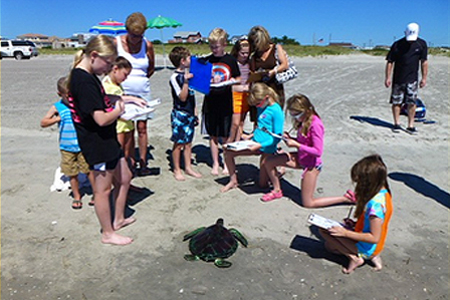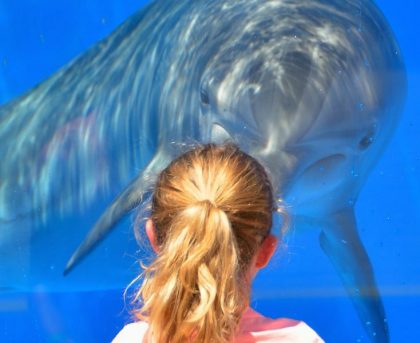
School
Schedule a tour of the MMSC's facilities to see the observation tank, rescue vehicles, and more. For a more outdoor experience, students can go on a guided beach walk, learn about native flora and fauna, and explore concepts such as point/non-point source pollution and weather. They can also go seining for animal specimens and objects in the bay, and see what lies beneath the waves. The Mock Sea Turtle Stranding program lets students assume the role of an MMSC technician, and learn the steps to a successful sea turtle rescue. Outreach programs are also available; presentations are interactive and have the option to include animal artifacts or a virtual tour of the Center.
supports classroom learning in:
Environmental Studies.
topics covered:
animals, birds, climate, ecology, plants, pollution, marine life.
contact info
Name: MMSC Education
Phone: 609-266-0538.
Email: [email protected]
INFO
ABOUT
Marine Mammal Stranding Center
The MMSC is responsible for the rescue and rehabilitation of marine mammals throughout New Jersey. The museum's exhibits include life-sized replicas of marine mammals and fish, pollution displays, whalebones, artifacts, and a "Please Touch" display. Visitors can also see a 1000-gallon observation tank in the summer, filled with unusual local and incidental fish; and cameras that allow them to see inside the Pool House, where the Center keeps larger animals, like whales and dolphins, during rescue and final rehabilitation. Educational programs including tours, outdoor summer programs, and beach walks are available.
contact info
Hrs: Sat. 10AM-2PM, Sun. 11AM-2PM, & By appointment.
HELPFUL LESSON PLAN(S)
Prepared by FieldTripDirectory.com
Aquarium Lesson Plan
FUN FACTS
• Did you know a sea cucumber can shoot its intestines at predators, and then regrow them, in order to avoid being eaten?
• An electric eel can produce 500 watts of electricity (that’s enough to light up 10 light bulbs) to frighten away predators.
• Dolphins sleep with one half of the brain and one eye open to watch for danger.
• No matter how many pieces you cut a sea sponge into each piece will continue living and growing.
• Ocean life can do amazing things to survive. As you visit an aquarium with your students, note the different ways animals defend themselves. Just like a squid, people wouldn’t bother you either if you squirted black ink in their face!
View Lesson Plan>>
Camp
Campers can choose from a number of programs during the spring and summer months. Opportunities for learning on the beach include going on a guided walk, and learning about flora and fauna; going bay seining as they look for specimens; and more. They can also learn about marine science, terrapins, whales, and more. Many programs offered at multiple locations. Outreach programs are also available, and are interactive with presentations and the option to include animal artifacts or a virtual tour of the Center.
topics covered:
animals, birds, climate, ecology, plants, pollution, marine life
contact info
Name: MMSC Education
Phone: 609-266-0538.
Email: [email protected]
INFO
ABOUT
Marine Mammal Stranding Center
The MMSC is responsible for the rescue and rehabilitation of marine mammals throughout New Jersey. The museum's exhibits include life-sized replicas of marine mammals and fish, pollution displays, whalebones, artifacts, and a "Please Touch" display. Visitors can also see a 1000-gallon observation tank in the summer, filled with unusual local and incidental fish; and cameras that allow them to see inside the Pool House, where the Center keeps larger animals, like whales and dolphins, during rescue and final rehabilitation. Educational programs including tours, outdoor summer programs, and beach walks are available.
contact info
Hrs: Sat. 10AM-2PM, Sun. 11AM-2PM, & By appointment.
HELPFUL LESSON PLAN(S)
Prepared by FieldTripDirectory.com
Aquarium Lesson Plan
FUN FACTS
• Did you know a sea cucumber can shoot its intestines at predators, and then regrow them, in order to avoid being eaten?
• An electric eel can produce 500 watts of electricity (that’s enough to light up 10 light bulbs) to frighten away predators.
• Dolphins sleep with one half of the brain and one eye open to watch for danger.
• No matter how many pieces you cut a sea sponge into each piece will continue living and growing.
• Ocean life can do amazing things to survive. As you visit an aquarium with your students, note the different ways animals defend themselves. Just like a squid, people wouldn’t bother you either if you squirted black ink in their face!
View Lesson Plan>>
